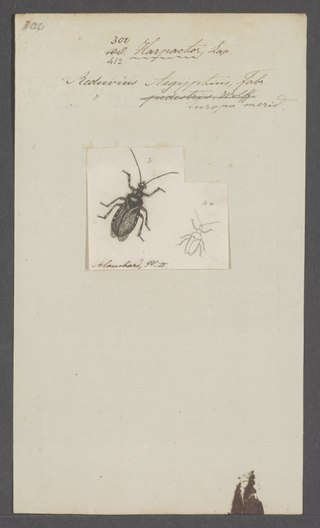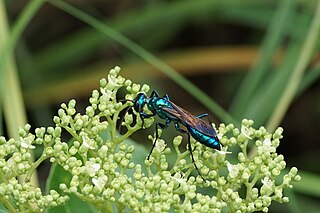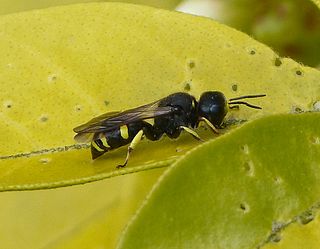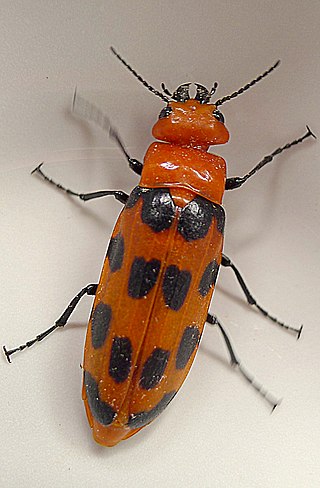
Carpenter bees are species in the genus Xylocopa of the subfamily Xylocopinae. The genus includes some 500 bees in 31 subgenera. The common name "carpenter bee" derives from their nesting behavior; nearly all species burrow into hard plant material such as dead wood or bamboo. The main exceptions are species in the subgenus Proxylocopa, which dig nesting tunnels in suitable soil.
Ebbe Schmidt Nielsen was a Danish entomologist influential in systematics and Lepidoptera research, and an early proponent of biodiversity informatics. The journal Invertebrate Systematics was established with significant contributions from Nielsen, and he assisted in the founding of the Global Biodiversity Information Facility (GBIF). Nielsen wrote several books, published over eighty scientific papers, and was highly regarded within the scientific community. Following his death, the GBIF organised the Ebbe Nielsen Prize in his memory, awarded annually to promising researchers in the field of biodiversity informatics. The moth Pollanisus nielseni is named after Nielsen.
The Catalogue of Life is an online database that provides an index of known species of animals, plants, fungi, and microorganisms. It was created in 2001 as a partnership between the global Species 2000 and the American Integrated Taxonomic Information System. The Catalogue is used by research scientists, citizen scientists, educators, and policy makers. The Catalogue is also used by the Biodiversity Heritage Library, the Barcode of Life Data System, Encyclopedia of Life, and the Global Biodiversity Information Facility. The Catalogue currently compiles data from 165 peer-reviewed taxonomic databases that are maintained by specialist institutions around the world. As of September 2022, the COL Checklist lists 2,067,951 of the world's 2.2m extant species known to taxonomists on the planet at present time.

Anterhynchium is an Afrotropical, Indomalayan, Australian and Palearctic genus of potter wasps. As in many species of wasp, female wasps defend against predation using a modified ovipositor to sting predators. Like some other wasps in the Vespidae family, male wasps can produce a "pseudo-sting" with two sharp spines on either side of their genitals; however, unlike in the females, this "sting" is venomless.
The World Register of Marine Species (WoRMS) is a taxonomic database that aims to provide an authoritative and comprehensive list of names of marine organisms.

Hellula is a genus of moths of the family Crambidae. It was described by Achille Guenée in 1854

Nanosiren garciae is an extinct sirenian dugong that lived in warm shallow seas in what is now Venezuela, approximately 11.610—3.6 Ma during the Miocene and Pliocene. The species is listed in the Paleobiology Database, funded by the Australian Research Council.

Harpactor is a genus of assassin bug family (Reduviidae), in the subfamily Harpactorinae.
The Atlas of Living Australia (ALA) is an online repository of information about Australian plants, animals, and fungi. Development started in 2006. The Commonwealth Scientific and Industrial Research Organisation (CSIRO) is an organisation significantly involved in the development of the ALA. The Atlas of Living Australia is the Australian node of the Global Biodiversity Information Facility. The ALA is being used to help assess suitability of revegetation projects by determining species vulnerability to climatic and atmospheric change.

Chlorion is a genus of parasitoid wasps in the family Sphecidae. Species have been recorded from the Americas, Africa and tropical Asia through to Java; they appear to prey mostly on Orthopteran insects.

iNaturalist is an American 501(c)(3) nonprofit social network of naturalists, citizen scientists, and biologists built on the concept of mapping and sharing observations of biodiversity across the globe. iNaturalist may be accessed via its website or from its mobile applications. iNaturalist includes an automated species identification tool, and users further assist each other in identifying organisms from photographs. As of 9 July 2024, iNaturalist users had contributed approximately 197,660,888 observations of plants, animals, fungi, and other organisms worldwide, and 290,007 users were active in the previous 30 days.
Megachile rufitarsis is a species of bee in the family Megachilidae. It was described by Amédée Louis Michel Lepeletier in 1841.

Xylocopa auripennis, or Xylocopa (Biluna) auripennis, is a species of carpenter bee. It is widely distributed in South Asian countries, and Southeast Asian countries.

Crossocerus is a genus of square-headed wasps in the family Crabronidae. There are at least 250 described species in Crossocerus.
Hemipterochilis is a genus of potter wasps.

Ectemnius continuus is a species of square-headed wasp in the family Crabronidae. It is found in Africa, Europe and Northern Asia, North America, and Southern Asia.

Sebastiania dimorphocalyx is a species of flowering plant in the family Euphorbiaceae. It was described in 1874. It is native to Minas Gerais, Brazil.

Cissites maculata is a species of blister beetle that lives in the Neotropical realm.

Eulaema nigrita is a species of large-bodied bee in the tribe Euglossini, the orchid bees. It is commonly known as the black orchid bee. It is found from Costa Rica through northern Argentina. The species nests in pre-existing cavities.












